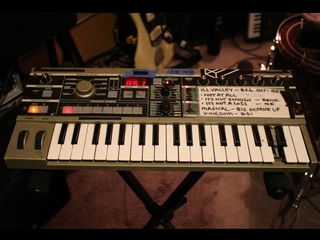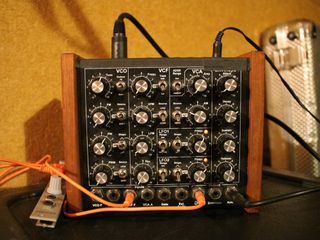Liars' gear in pictures
Post-punk cooperative's career in gear

Liars' years in gear
Angus Andrews and Aaron Hemphill cofounded art-damaged post-punk cooperative Liars near the turn of the millennium, recruiting percussionist Julian Gross in 2002.
First churning out angular punk-funk, à la a more digitally processed Gang of Four, Liars quickly transitioned into an outlet for oscillator exorcisms and abrasive, tribal grooves. In the past decade Liars have compiled an appropriately dense catalog that can range from monolithic and deranged to fragile and detached before swinging back to more approachable, while still sinister and insistent motifs.
Liars’ seventh and most recent album, 2014’s Mess, recalls in part the post-industrial, bluntly percussive style of EBM (electronic body music) that peaked in the early ’90s on the Wax Trax! label. A seemingly unflagging sense of tension comes from the band’s willingness to morph publically, consolidating new means to deliver brooding, pitch-bent perversion before our eyes. For Liars, the constant is restlessness. Here is a brief glimpse into Liars’ progression through the band’s equipment accumulation, presented in chronological order.

Gibson SG American Standard
This guitar was bought in ’98, and I met Angus in January of ’99. When we first started making songs on a four-track together it was with this guitar.
It was the main guitar when we toured for our first album, [2001’s] They Threw Us All In A Trench And Stuck A Monument On Top, and Angus played it quite a bit on our self-titled album [from 2007]. This piece of equipment has been with us longer than any other, and therefore has a bit of sentimental value to it.

Korg microKORG
We acquired this right before we made our second album, [2004’s] They Were Wrong, So We Drowned. Angus was a step ahead of me in utilizing synths.
Back then I wasn't so into them myself, but Angus found some great sounds with this [MIDI-capable virtual analog] synth that are on our second record, and it has been a secret weapon on many records ever since.

Native Instruments Reaktor
This is a screenshot of one of the many Reaktor ensembles in our arsenal. We first started using the computer as an instrument on our sixth album, [2012’s] WIXIW.
We had used computers for recording purposes for a long time, and had become quite familiar with using them in that regard. In hindsight it seems crazy that it took us so long to get into Reaktor [a modular synthesis studio], but we were fascinated by other things at the time, I guess, which took precedence.
It was also quite daunting, or quite honestly terrifying, when we finally did try to learn more about this world. With some experience and some experiments behind us, I think we're now realizing that music programs are just like any other instrument we've used. It's all about the idea you have, not how much you've mastered an instrument.

Korg MS2000
While learning how to use Reaktor, we felt like we missed the more tactile pleasures of physical instruments and the greater chance of mistakes happening that they provide.
Mistakes have always been greatly valued by us in the songwriting process, as they lead you to places within your idea you've never been to before.
The MS2000 [a physical modeling synthesizer produced in 2000] is just one of the few real synths we coupled with softsynths for our last two albums. We can't say we prefer one over the other; it's more for us about what's available at the time and what works for the song. We're quite happy to explore both worlds of synthesizers.

Doepfer Dark Energy
Another analog synth used in conjunction with music software; we've had this thing for three years now and we're still able to generate new sounds from it.
This is the first-generation Dark Energy [a monophonic standalone synthesizer with USB and MIDI interface] that they stopped making to make way for the Generation 2. I have to say I'm a bit partial to the Generation 1.
Differences include the Gen 1 being based on a triangle wave, whereas the Gen 2's are based around a sawtooth wave. Also, the reason for its discontinuation is the apparent scarcity of the Curtis Chip the Gen 1 featured.
It's great learning new tricks and physics by experimenting with physical analog synths and applying them to the programs we use. This works both ways as well when experimenting within programs.









